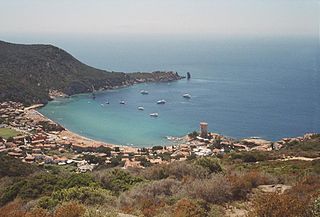
Isola del Giglio is an Italian island and comune in the Tyrrhenian Sea, off the coast of Tuscany, and is part of the Province of Grosseto. The island is one of seven that form the Tuscan Archipelago, lying within the Arcipelago Toscano National Park. Giglio means "lily" in Italian, and though the name would appear consistent with the insignia of Medici Florence, it originally derives from the Latin name of the island, Igilium, which in turn could be related to the Ancient Greek name of the neighbouring Capraia, Αἰγύλιον, from Ancient Greek: αἴξ, romanized: aíx, lit. 'goat'.

Lipocosma is a genus of moths of the family Crambidae.

Giglio Campese is a village in Tuscany, central Italy, administratively a frazione of the comune of Isola del Giglio, province of Grosseto. At the time of the 2001 census its population amounted to 154.
Lipocosma albibasalis is a moth in the family Crambidae. It is found from Costa Rica to coastal Brazil.
Lipocosma antonialis is a moth in the family Crambidae. It is found in Bolivia.
Lipocosma coroicalis is a moth in the family Crambidae. It is found in Bolivia.
Lipocosma diabata is a moth in the family Crambidae. It is found in North America, where it has been recorded from Florida.
Lipocosma forsteri is a moth in the family Crambidae. It is found in Bolivia.
Lipocosma grimbaldalis is a moth in the family Crambidae described by William Schaus in 1924. It is found in Guatemala.
Lipocosma hebescalis is a moth in the family Crambidae. It is found in Puerto Rico.
Lipocosma intermedialis is a moth in the family Crambidae first described by William Barnes and James Halliday McDunnough in 1912. It is found in North America, where it has been recorded from Texas and Maryland.
Lipocosma polingi is a moth in the family Crambidae. It is found in North America, where it has been recorded from Arizona and central and southern Texas.
Lipocosma sabulalis is a moth in the family Crambidae. It is found in Venezuela.
Lipocosma saralis is a moth in the family Crambidae. It is found in Bolivia.
Lipocosma teutonialis is a moth in the family Crambidae. It is found in Brazil.
Lipocosma ausonialis is a moth in the family Crambidae. It was described by Herbert Druce in 1899. It is found from Guatemala to central Costa Rica.
Lipocosma chiralis is a moth in the family Crambidae. The moth was described by Schaus in 1920, and today is found in Cuba.
Lipocosma furvalis is a moth in the family Crambidae. It was described by George Hampson in 1912. It is found from Mexico south to Costa Rica and the Lesser Antilles.

Lipocosma sicalis is a moth in the family Crambidae. It was described by Francis Walker in 1859. It is found in North America, where it has been recorded from Alabama, Arkansas, Florida, Georgia, Illinois, Indiana, Kansas, Maryland, Massachusetts, Mississippi, Missouri, New Hampshire, North Carolina, Ohio, Oklahoma, Ontario, South Carolina, Tennessee, Texas and West Virginia.

Lipocosma adelalis is a moth in the family Crambidae. It was described by William D. Kearfott in 1903. It is found in the US states of Indiana, Mississippi, Missouri, New Jersey, North Carolina, Ohio, South Carolina, Tennessee and West Virginia.



